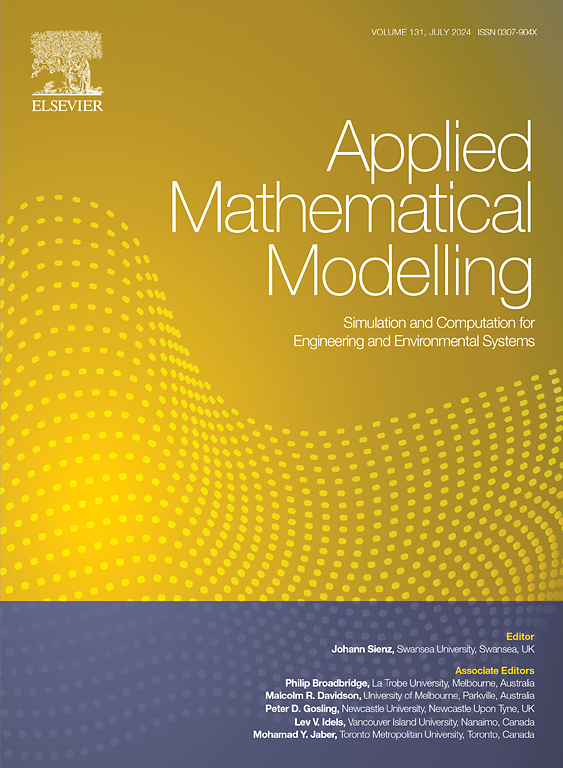A simple approach for effective CFD simulation of turbulent pipe transport of shear-thinning, power-law fluids
IF 4.4
2区 工程技术
Q1 ENGINEERING, MULTIDISCIPLINARY
引用次数: 0
Abstract
This study presents a simple, efficient approach for the CFD simulation of turbulent pipe transport of shear-thinning, power-law fluids. The method is developed within the Newtonian-based Reynolds-Averaged Navier-Stokes (RANS) framework, and it relies on a modification to the Reynolds-averaged apparent viscosity function to compensate for errors induced by the non-decomposition of the instantaneous apparent viscosity, as well as for the use of turbulence models developed for Newtonian fluids. Specifically, the Reynolds-averaged apparent viscosity switches from a power law to a logarithmic function for averaged shear rates below a threshold value, called the “critical shear rate”, which becomes a calibration parameter of the model. The new framework was tested against DNS data reported in the literature for different pipe-flow conditions, covering combinations of flow index and friction Reynolds number , as well as against well-established correlations for the friction factor, with the analysis extended to cases up to and . The analysis was conducted by employing three different turbulence models, namely Lam-Bremhorst k-ε, two-layer k-ε, and k-ω SST, which all rely on a low-Reynolds number treatment to obtain a detailed flow description in the near-wall region. The proposed approach appears attractive from an engineering standpoint, as it allows obtaining reasonably accurate prediction of main features of turbulent pipe transport of shear-thinning, power-law fluids, with a simple mathematical formulation and a robust and easy-to-converge character that can make a difference for the application to more complex flows.
一种有效的CFD模拟剪切变薄幂律流体湍流管道输运的简单方法
本研究提供了一种简单、有效的CFD方法来模拟剪切变薄、幂律流体的紊流管道输运。该方法是在基于牛顿的reynolds -average Navier-Stokes (RANS)框架内开发的,它依赖于对reynolds -average表观粘度函数的修改,以补偿瞬时表观粘度未分解引起的误差,以及使用牛顿流体开发的湍流模型。具体来说,当平均剪切速率低于临界值(称为“临界剪切速率”)时,雷诺数平均表观粘度从幂律变为对数函数,该临界值成为模型的校准参数。根据文献中报道的不同管道流动条件下的DNS数据对新框架进行了测试,包括流动指数n={1.0,0.8,0.6}和摩擦雷诺数Reτ={323,500,750}的组合,以及摩擦力因子的既定相关性,并将分析扩展到n=0.4和Reτ=2,500的情况。采用Lam-Bremhorst k-ε、双层k-ε和k-ω SST三种不同的湍流模型进行分析,这些模型都依赖于低雷诺数处理来获得近壁区域的详细流动描述。从工程角度来看,该方法很有吸引力,因为它可以相当准确地预测剪切变薄、幂律流体的湍流管道输送的主要特征,并且具有简单的数学公式和鲁棒性和易于收敛的特性,这对于应用于更复杂的流动具有重要意义。
本文章由计算机程序翻译,如有差异,请以英文原文为准。
求助全文
约1分钟内获得全文
求助全文
来源期刊

Applied Mathematical Modelling
数学-工程:综合
CiteScore
9.80
自引率
8.00%
发文量
508
审稿时长
43 days
期刊介绍:
Applied Mathematical Modelling focuses on research related to the mathematical modelling of engineering and environmental processes, manufacturing, and industrial systems. A significant emerging area of research activity involves multiphysics processes, and contributions in this area are particularly encouraged.
This influential publication covers a wide spectrum of subjects including heat transfer, fluid mechanics, CFD, and transport phenomena; solid mechanics and mechanics of metals; electromagnets and MHD; reliability modelling and system optimization; finite volume, finite element, and boundary element procedures; modelling of inventory, industrial, manufacturing and logistics systems for viable decision making; civil engineering systems and structures; mineral and energy resources; relevant software engineering issues associated with CAD and CAE; and materials and metallurgical engineering.
Applied Mathematical Modelling is primarily interested in papers developing increased insights into real-world problems through novel mathematical modelling, novel applications or a combination of these. Papers employing existing numerical techniques must demonstrate sufficient novelty in the solution of practical problems. Papers on fuzzy logic in decision-making or purely financial mathematics are normally not considered. Research on fractional differential equations, bifurcation, and numerical methods needs to include practical examples. Population dynamics must solve realistic scenarios. Papers in the area of logistics and business modelling should demonstrate meaningful managerial insight. Submissions with no real-world application will not be considered.
 求助内容:
求助内容: 应助结果提醒方式:
应助结果提醒方式:


